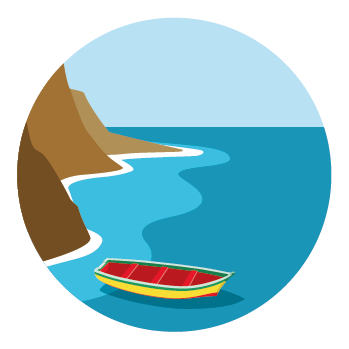
The Republic of Cabo Verde is an African archipelago, which depends largely on marine resources. Their coastal areas ensure human wellbeing through resources availability (e.g. food) and jobs. However, coastal regions in Cabo Verde are highly exposed to natural hazards and to multiple pressures associated with anthropogenic activities, including reclamation of wetlands for agriculture, water contamination and plastic pollution. They are, thus in an enormous need for sustainable development of activity sectors linked to the sea, i.e. Blue Growth. Cabo Verde is a country where Blue Growth can help to contribute with solutions for current issues, such as high poverty rates, while building on the long tradition of local economical use of the marine environment. However, no valuable baseline knowledge on the environmental status of their marine ecosystems is available, hampering the development of measures ensuring their sustainable use, management, conservation and restoration. Information on marine habitats for this archipelago is scarce, and there is no integrated evaluation of marine resources to support knowledge-based regulations and guidelines for their sustainable use, in line with the national development trends. Santo Antão has the highest poverty rate of the Archipelago and income inequalities and is highly vulnerable to extreme natural phenomena.
The COAST project will significantly contribute to understanding the status and functioning of the ocean system around Santo Antão island in Cabo Verde, as its contribution to the country’s economy. The project aims to achieve 5 main objectives: a) to characterize and map pelagic and benthic habitats, as well as anthropogenic pressures of Santo Antão, b) to estimate patterns of diversity in marine communities in relation to habitat features, c) to assess the vulnerability of the studied communities to both environmental and anthropogenic pressures, through the application of risk assessment models, d) to implement conservation and restoration actions for selected habitats/ecosystems based on the results of the first three objectives, e) to provide baseline data that inform policymakers, authorities, institutions and practitioners towards effective marine conservation and restoration in these habitats and demonstrate the repeatability of the proposed approach in other regions. Dedicated scientific surveys will be conducted to collect data from the marine ecosystems around Santo Antão under a transdisciplinary and integrated framework, with a specific focus on selected areas of interest. We will apply state-of-the-art technology, combining visual and acoustic observations with physical sampling, modelling and remote sensing. COAST expects to improve current knowledge on marine habitats of Santo Antão island and to provide efficient management recommendations for their sustainable development, along with mitigation plans for the effects of global changes, in line with the needs of stakeholders and local communities.
